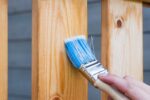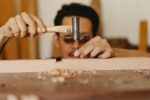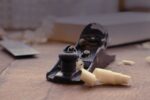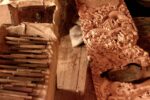How To Use A Handheld Circular Saw For Accurate Cuts

Ah, the handheld circular saw – the trusty workhorse of any DIYer’s tool collection. Whether you’re building a bookshelf, framing a wall, or just cutting down some lumber for your latest project, the circular saw is a go-to tool for making quick and precise cuts.
But let’s be honest – it can also be a bit intimidating, especially if you’re new to woodworking or DIY. How do you make sure you’re cutting straight and true? And what about those tricky angled cuts? Fear not, my friends – we’re here to help.
In this article, we’ll break down everything you need to know about how to use a handheld circular saw for accurate cuts. From choosing the right blade to setting up your saw for perfect cuts every time, we’ve got you covered. So grab your saw and let’s get cutting!
Prepare the Wood

If you wanna make accurate, clean cuts, you’ve got to start by learning how to prep the wood. This is not an area where you want to embarrass yourself – it’s all about getting the right tools and having good technique.
First things first, let’s choose the right blade for the job. A crucial rule in carpentry is that the blade size must be just right for the task. Anything else and you’ll end up with an inefficient cut.
Once you have chosen the perfect blade, the next step is to secure the board on the surface you’ll be sawing it on. This helps reduce errors due to any shifting of the wood and it also makes sure the cut is true. You can do this by using clamps or even tape as long as it’s securely in place.
It goes without saying that you also want to make sure you have enough power to carry out the job. This could be done through a power source such as a stationary saw or a hand-held electric saw. Whichever option you go for you’ll need to make sure you have the right power source to back it up.
Lastly, try to calculate what the depth of each cut should be. This isn’t too difficult to do and you should be able to work out the required depth after taking a few measurements and considering the type, size and thickness of the wood. So make sure you do this part correctly before cutting as this could affect the accuracy of your cuts.
By following these steps you should have everything you need to get your cuts prepped and ready for the big saw. Now all that’s left for you to do is to pick up the saw and get sawing!
Choose the Right Blade
With a handheld circular saw in hand, you’re ready to make any cut you’d like. But, before you get to chopping, you need to make sure that blade you’re about to use is the right one for the job. Hey, if I know anything about cutting, it’s that the blade is everything! Selecting the wrong blade can cause unnecessary kerf and result in a rough, sloppy cut. For that reason, it’s important to use the correct size.
Most circular saw blades range in size from as small as 4 inches up to 12 inches, with the most common size being 7.25 inches. While that’s the standard size, it can vary among different saw models and manufacturers. So, it’s important to check the dimensions of your blade in the product manual. All circular saws come with a blade that’s labeled by size. Therefore, no matter what size blade you have, you’ll know its size just by looking at it.
Once you’ve determined the size of your blade, the kind of cut you want to make will determine the type of blade you need. Generally, a flat-tooth blade is perfect for making crosscuts and a variable-tooth blade is suitable for rip cuts. It’s essential to remember that a variable-tooth blade isn’t always better for all cuts. Therefore, it’s advised that you change the blade according to the type of cut.
The number of teeth on a background can also be a factor when choosing the right blade. Circular saw blades usually range from 24 to 80 teeth with more teeth per blade providing a smoother, more precise cut on the workpiece. Additionally, the teeth of the blade can either be pointed or angled for efficient and fast cutting.
After making important considerations about size, type and teeth, it’s also important to think about the material of the blade. Generally, a carbide-tipped blade is utilized for cutting hardwoods, while a steel-tooth blade works well with softwoods.
I hope you’ve been able to figure out which blade is right for the job by now. Choosing the right blade is essential for making the precise and smooth cuts. With the right blade equipped, you’re all set to start cutting!
Clamp Down the Wood
You must remember to clamp down the wood before attempting a cut. This is lowkey the most important part of making accurate cuts. If your wood isn’t held in place, then there is a good chance you will mess up and cut at an angle or incorrect length. No one wants that.
Well, if it isn’t clamped down, you might as well just roll the dice. This step is like the end of a fight, you must make sure your opponent is Secured. I keep saying clamped down, but if you prefer the term secured, we can call it that too.
Clamping down essentially means you must use a clamp that has either a C-Clamp or a handscrew. These clamps come with your handheld circular saw, so there’s no need to buy a separate one. Basically, what you do is place the clamp on the sides of the wood to secure it and then tighten the wing nut to make sure everything remains in place.
Don’t make the mistake of using a vise to clamp down your wood because it can cause an uneven surface and you definitely don’t want that. Plus, it can cause a lot of kickback and that’s not cool man. I know the vise can be tempting, but it’s a definite no-no.
Once you’ve clamped the wood down, you’ll be ready to make the accurate cuts you’ve been dreaming of. So go ahead and secure that wood! Remember, don’t skimp in this department! It’ll turn out to be a fun time. I promise. Even if, you don’t enjoy it, at least you know all your hard work will pay off when you see those accurate cuts in the end. Cheers!
Make Sure the Reached Power Source is Enough

If you’re using a corded circular saw, you’ll of course have to make sure that the power source that you have reached is enough for the job. If you don’t have a gauge or an electrician available to help, use this trick to make sure that you’re all set. First, take a piece of wood that’s equal in size to the actual plank you’ll be cutting. Now plug your circular saw into the same power source that you’ll be using later on. Turn the saw on and slowly, slowly push the saw against the plank – if and only if the saw starts cutting through the wood, the power source is enough. If not? Well, you’ll feel like a fool and will have to find another way to get the job done, Murphy-style!
The most important thing is to focus, not to rush and if you do happen to get the power source wrong, don’t worry about it. Just use my hack and next time you’ll be the one laughing – not me!
Calculate the Depth of your Cut
Alright y’all, it’s time for us to talk about calculating the depth of your cut. Determining the correct depth of your cut is very important when you’re working with wood and a saw. First things first, measure the length of the wood you’re cutting. If it’s a long piece, make sure you’re not cutting deeper than it is. Now, mark off the area that you want to cut, and make sure to measure the width and depth of the inside to find out how deep you’re going to cut.
Next, measure the blade of your saw. This will give you the radius of the blade when you start cutting. Your depth of cut should never exceed the radius of the saw. If you cut deeper than the radius of the saw, you can grab yourself a different saw. Got it? Great.
Finally, to calculate the depth of your cut, subtract the radius from the length of the wood you’re cutting. This will give you the deepest cut you should make. However, if you don’t want to risk cutting too deep, a safe bet would be to cut about halfway in the wood.
Now that you know the correct depth of your cut, it’s time to get to work. But before you do, make sure you set up all safety precautions so that you don’t end up with injuries. Wearing protective gear and keeping the surrounding area clear of loose objects is key!
So, there you have it! Calculating the correct depth of your cut is crucial when using a handheld circular saw, but with a little bit of basic math, you’ll have it figured out in no time. Now let’s get to work and make those beautiful cuts!
Use the Circular Saw
When it comes to making accurate cuts, old-school carpentry methods simply won’t cut it (no pun intended). The only way to get perfectly straight, accurate lines every single time is to use a handheld circular saw. Sure, directions may vary depending on the model you are using, but this section should be more than enough to equip you with the know-how to make your own accurate cuts.
First things first, you need to adjust the saw blade to the right depth. This can be done either manually or with the help of a depth-adjustment system. If you are using a handheld circular saw for the first time, I suggest manual adjustments as they are easier to understand and control. Once you set the saw blade to the required depth, you can start reading up on the manufacturer’s instructions. It is important to familiarize yourself with how to use the saw correctly and what safety measures you need to take.
Now it is time to make the cut! If you want to make straight lines, I recommend using a straightedge or miter guide. This will help keep the proper distance between your wood and the saw blade and will allow you to create accurate, straight lines every single time. When making a crosscut, hold the saw with both hands and move it steadily. To make a rip cut, you can secure the wood at both ends and use a plunge cut technique.
If you plan on making different cuts throughout your project, remember to reset the blade back to the required depth from time to time. That way, you will achieve the desired result each and every single time.
As you make the cuts, keep in mind a few safety tips. It is important to wear protective gear such as noise-canceling headphones and safety goggles to protect yourself from any accidents. Also, make sure to secure loose pieces of equipment and never use a cordless circular saw near any water sources. Finally, make sure to keep your cuts smooth and neat for best results.
And there you have it! Everything you need to know about using a handheld circular saw for accurate cuts. Now go out there and make some masterpieces!
Set the Blade at the Right Depth
Alright! Now that you have all the tools and equipment ready and the wood clamped down, all that’s left is to actually use the saw. The first step there is to make sure you have set the blade of the saw at the right depth. Otherwise, all your hard work was for nothing, and you still won’t get the perfect cut you’re aiming for. Fear not though! I will show you the right way to set the blade depth so that you can get your accurate cuts!
For starters, make sure you use the right size blade for the job, otherwise the depth of the cut won’t work out. Then, use the saw’s depth-adjustment scale to set the blade’s depth and make sure it is correct. Pay careful attention when setting the blade’s depth—it shouldn’t be too shallow or too deep. Once you’ve figured that out, you’re ready to make the cut.
I and the elves here recommend that you use a ruler or other measuring device to make sure the blade is set to the right depth. Not only does this ensure accuracy, but it’s also a lot safer. You don’t want to come up with a mangled piece of wood that’s not even close to what you wanted when you started—now do you? That would just be a bummer.
Also, if you’re using a handheld circular saw, keep in mind that some come with a depth indicator feature. This is super helpful as it will make it easier for you to have the blade set at the correct depth without any guesswork. All you have to do is line up the indicator with the saw’s depth-adjustment scale and you’ll be good to go.
And that’s that! Now you’re all ready to move on to the next step in perfectly cutting your wood. Just make sure the blade is set to the right depth, and you’ll be golden.
Read the Manufacturer’s Instructions

Hey everyone! Today we’re talking about one of the most intimidating tools out there… the handheld circular saw! Lucky for you, I’ve got a few tips to make sure you’re using it safely and accurately.
Did I mention safety? Yeah, it’s really important. Before we get into the nitty-gritty of using your circular saw, let’s go over the basics – and for this we need to read those darned manufacturer’s instructions. Ugh.
Don’t worry; the instructions are probably tucked inside the box the saw came in. Yes, it’s boring. But it’s also important, so let’s get at it before we fire her up and start cutting.
Long story short, the instructions will tell you things like what type of material your saw is safe for – like wood. They’ll also tell you about any special features your saw might have and how to use them safely. Read the instructions, I’ll wait…
Ok, you back? Great! So now that you’ve got the scoop on your saw’s features, let’s get started. Oh, one more thing before we get too far – the instructions may recommend lubricating your saw’s cooling system and blade area at regular intervals. You won’t want to miss this step, so be sure to keep an eye out for that.
Alrighty, it looks like we’ve done our reading for today. All we need now is a few good safety tips and we’ll be good to go. Let’s keep movin’!
Make the Cut
Sawing wood for a project is probably something you’ve done if you’re a woodworking enthusiast. But how to do it with a handheld circular saw for accurate cuts?
So, let’s get started, daddy. When you’re all set and the wood is clamped down and the blade is at the right depth, what you have to do next is make the cut. Before you start, triple check that the power source is enough. Don’t do the wrong calculations and end up saying “aww jeez” like Steve Urkel. So, time to put the power to the saw.
Now, it’s time to hold the saw against the wood, in the right position, and let the blade do the work. Lightly press the trigger of the saw and bring it to the required speed. Make sure you hold the saw steady as you move it against the wood. Oh, I almost forgot! Don’t forget the wood chips that the saw may be creating as it cuts, don’t let them ruin your project plans.
While sawing, hold on to the saw firmly, direct it well and fix it in place. Don’t let it go around like a whirling dervish, that’s no way to get a good cut. Press down gently as you guide the saw along so it does a neat job. If you need to, move the wood through the saw for certain cuts.
Once the cut is done, you’re almost there! You see, wasn’t it easy? Now you have the cut you wanted and can use it to complete your project. It was easy as one, two, three.
Reset for Different Cuts
If you’re a pro looking to get real good with the handheld circular saw then you’ll eventually hit a point where you need to make different cuts. Nothing wrong with that! And thankfully most circular saws these days are pretty versatile when it comes to making different cuts, as long as you know how to properly adjust them.
Before you start making any cut, you want to make sure that the saw is set correctly. This means that depending on the type of cut you plan on making, you’ll want to reset the angle or depth of the saw blade. The process of resetting the saw is the same regardless of cut, but the angle or depth will be different.
For a straight cut, you’ll want to set the angle all the way back to its original position. This way the blade is level with the surface of the wood. For oblique cuts you’ll want to set the angle of the saw blade to match the angle of the desired cut. As for the depth you’ll want to determine the depth of the cut before making any adjustments.
Next you’ll want to prepare the saw for an acute angle cut. To do this, you’ll need to tilt the base of the saw slightly and adjust the depth of the blade accordingly. Remember, this cut will require you to apply pressure in both directions so it’s important that the blade is set at the right depth.
Finally, if you plan on making a deep bevel cut then you’ll want to adjust the saw in a way similar to the acute angle cut. The only difference is that instead of just tilting the base, you’ll also want to rotate the saw housing to the desired angle, then adjust the blade accordingly.
Now that all the different cuts are out of the way, you want to make sure your saw is back to its original position. All you need to do to complete the reset is set the angle and the depth back to their original settings and you should be good to go.
There, now you’re a master in resetting the saw for different types of cuts. So nothing should be stopping you from executing the planks of your dreams! There’s no denying that mastering the art of the circular saw takes a bit of practice, but if you keep practicing that baby you’ll get real good in no time. Good luck!
Safety Tips

Hey folks, you’ve made it this far. You’ve got your wood prepared and you know how to use a handheld circular saw and you’re ready to make some clean and accurate cuts. But before you jump in, I just want to remind you of a few safety tips.
First and foremost, safety gear is essential when using a circular saw. That means, at minimum, you need to be wearing eye protection and a face mask. We don’t recommend using one without protective gear, so go ahead and get suited up!
Second, using a guide is a great way to ensure that your cuts are both accurate and straight. Make sure the square or whatever style of guide you’re using is custom fit for your saw and is also properly secured down to your workbench.
And third, always give your saw a once over to make sure all moving parts are securely fastened and that the cord is in good condition. Loose pieces of equipment can cause the saw to malfunction or even fly off and cause injury.
Finally, please don’t use a cordless circular saw near any water sources, such as a sink or swimming pool. This can pose a serious risk of an electric shock.
Now you’re all set. With this advice in mind, go ahead and make those clean and accurate cuts and keep them looking neat and smooth. Good luck!
Wear Protective Gear
If you’re gonna saw, I recommend doing it the safe way… and to do that, you’ll need to wear protective gear. Before you get started, get yourself a pair of safety goggles and some earplugs.
For your safety, consider wearing gloves too. I won’t tell you what to do, but it’s in your best interest to take precautions. After all, sawing isn’t just about cutting into the wood – it’s about keeping yourself safe. Wearing protective gear will help you do that.
You don’t want to be like me when I got my very first circular saw. I was so excited, I just charged right in without a care in the world. As you can imagine, I didn’t have safety goggles or earplugs on, and I ended up with a noise-induced migraine! Needless to say, I learned my lesson and now I’m always sure to equip myself with all the necessary safety gear.
If you want to be extra safe, you can also wear a face shield. That way, if you’re working with shorter pieces of wood, you don’t risk sawdust or wood chips getting into your eyes. I mean, would you really enjoy having wood chips in your eye?! Didn’t think so. That’s why you should always wear a face shield when you’re using a circular saw, no matter how short or long the pieces are.
And, here’s a tip: You can also wear a dust mask. This will help protect your lungs from any sawdust and wood chips you might inhale. Your lungs are precious, and you need to take care of them!
So, if you’re gonna saw, bring along your goggles and ear plugs, and don’t forget about your gloves, face shield, and dust mask. They might not be the coolest fashion statements in the world but, trust me, you’ll be glad you put them on when you’re done sawing!
Use a Guide to Make Sure the Cuts are Straight

Are you looking for the straightest cuts possible with a handheld circular saw? Then you must use a guide. Now, I know what y’all are thinking – Why should I use a guide? Well, folks here’s why:
Using a guide ensures that your cuts are as accurate as possible. It gives you a straight edge and line to follow when going along the wood. Of course, that’s only if you have the right guide that’s in perfect alignment. If your guide isn’t in alignment, then the cuts won’t be straight.
When it comes to guides, y’all have a few options:
First, you can use a straightedge guide. This is basically a straight edge (usually a large piece of wood) that you can use to guide your saw blade. Make sure you mark the right cutting line before using a straightedge guide.
Second, you can also use a square guide. This guide has a right angle on each side, which you can use to keep your saw steady and guide the blade.
Lastly, there are the miter and rip guides. If you’re making angled cuts, then these guides are great to have. Just make sure the guide is made of sturdy and durable material, so it won’t get damaged while sawing.
No matter which guide type you use, it’s important to always start from the edge of the wood. That way, you can get the most accurate cuts possible. Also, make sure to secure the guide to the wood, so it won’t move during the cutting process.
Once you’re done cutting with the guide, you can remove it. But, if you need to make multiple cuts across the same board, then it’s better to just leave the guide attached to the wood. That way, you don’t have to reattach or realign it every time you make a cut.
Well, that’s all there is to using a guide when cutting with a handheld circular saw. Now go out there and make some straight cuts!
Secure Loose Pieces of Equipment
I know you’re excited, you wanna get cuttin’ on some wood, I get it. But before we start sawing away, we have some important safety tips to cover to make sure your experience goes off without a hitch. Let’s start by securing any loose pieces o’ equipment.
In between raisin’ the roof and fixin’ the sids, I’m sure you’ve seen carpenters usin’ tools to prepare the wood. To make sure those tools don’t start flyin’, the first thing you wanna do is take a look around. Make sure any tool which needs to be clamped down is held tight with a clamp or a vise. Ya don’t want any flyin’ objects when you’re using a circular saw.
Once you’re happy with the setup, double-check all the screws if your saw happens to be mounted to a table. If the screws are loose, make sure you tighten them before yer stick yer saw blade in the wood. The last thing you wanna do is tear out a section of your workbench when you’re in the middle of a cut. See, I told ya: secure any loose pieces of equipment before gettin’ to business and you won’t be in for any surprises later.
Finally, when it comes to yer power source, make sure all the connections are secure. If ya have an extension cord and it’s looser than a Fortnite dance, take a few minutes to snug things up. Sure, this may seem like a lot of prep work, but it’ll be worth it when you’re slicing wood like a hot knife through butter.
So, with our tools prepared and everything secure, all that’s left is to get sawin’ on wood. But don’t forget the safety precautions we went over before – they only take a few minutes of yer time, but they can make all the difference in the world. Make sure everything is clamped down and all yer screws are tight, secure all yer cords and connections, and you’ll be doin’ some precise cuts in no time. Trust me, I know what I’m talkin’ about.
Don’t Cordless Circular Saws Near Water Sources
Hey, ya’ll, here’s a tip for ya’ll that i want you to take very seriously, especially if you are a fan of the School of Handyman tips: DON’T cordless circular saws near water sources. Seriously, if you don’t want yourself or anyone around you to get hurt, stay away from water when you’re using one of those things.
Now, my guess is that you’re wondering why you can’t use something as innocuous as a portable circular saw near water, right? Well, here’s why. A cordless saw uses a rechargeable battery to make things work. That battery is prone to shorting out and sparking when exposed to water and wet surfaces. This could create an electrical hazard and create a high risk of electrocution.
So, to stay safe (and get on the good side of the School of Handyman tips) keep your circular saw away from water and wet surfaces. Even something as small as a drop of water on a cutting surface can cause a spark and that’s the last thing you want when you’re cutting wood.
I’m sure you want to do the job right and keep yourself safe at the same time, so give this advice from the School of Handyman tips a try: when using a cordless circular saw, make sure it’s away from anything water related. Be it a sink, swimming pool, garden hose or whatever, keep it well away so you won’t have any issues.
That’s all I got for ya’ll today, so keep these pro tips in mind the next time you reach for the cordless circular saw to get the job done. With this advice from the School of Handyman tips, you can keep yourself and anyone else around you safe and do a great job at the same time.
Keep the Cuts Smooth and Neat
No one likes a wonky edge or surface right? To keep your cuts looking neat and uniform, there are a few things you should always keep in mind.
First, when making the cut, make sure your saw is tilted at the right angle for the job. Some cuts, such as bevel cuts and miter cuts, require precision in the angle you set your saw too.
Second, make sure you have good depth control on the cut you’re making. Circular saws give you accurate cuts based on how deep you set the blade, so if you set the blade too deep your cut will end up looking rough and jagged.
Third, when you make your cut, make sure you’re using a steady, measured motion. If the saw moves too fast it can tear the wood fiber and leave behind an uneven surface. Taking your time to make a smooth oval shape will ensure a much higher quality cut.
Finally, a quick way to make sure you’re getting smooth, even cuts is to make a practice cut in a piece of scrap wood before you slap it into the project. This will help you get a sense of how deep you need to set your blade and how much resistance your saw should have as it moves through the material.
The bottom line is, taking your time and practicing with your saw can help you make the cuts you need with the absolute highest style. Don’t be afraid to take your time and practice cutting in your material. With a few quick and easy tips, you’ll be sure to have the perfect cut for your project.






